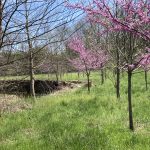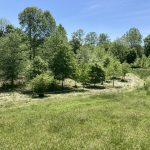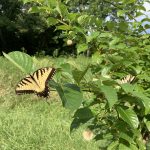Riparian Buffer

Mature riparian edge with beaver dam, just upstream from the restored buffer
Beardsley and Ridder steward about a mile and a half of Rappahannock riverbank, some of it on both sides of the river. Much of the floodplain was cleared ages ago right to the river edge for cropland, chiefly for cattle corn production. Without a riparian tree buffer, riverbanks were severely eroded, with places on the outside of bends where several feet of soil might be lost in a single flood event. Working with an organization called Friends of the Rappahannock in partnership with the Virginia Department of Forestry, they installed about 500 trees and shrubs in 2017 in a 35-foot-wide buffer along particularly bad sections of riverbank. Species were selected for soil stabilization along with wildlife habitat and food value, and included fast-growing trees like sycamore, tulip, and river birch, and slow-growing species like white, pin, and willow oak. Understory trees and shrubs included red osier and grey dogwood, redbud, elderberry, and hazelnut.
Trees were planted at a rate of about 220 per acre on 14-foot centers. Small whips were planted in tubes and staked; after several seasons of robust growth, tubes were removed from the larger trees. The survival rate was close to 80 percent, and trees within sight of the house are now up to 25 feet tall. Trees out of sight of the house have been heavily browsed by deer (except for river birches), so some of them are still barely out of the tubes. The riparian buffer is conscientiously managed during the growing season. Vegetation in the buffer is mowed two or three times a year, weed eaters are used to trim the grass around the trees (although glyphosate was recommended), and vines that grow inside the tubes are removed by hand. A few trees have been lost to beavers, but they seem to prefer places with thicker, older vegetation, and they have been quite useful in harvesting autumn olive (and, alas, some witch hazel).
See the species list.
More on Field Work
Pollinator Meadow
In an effort to create habitat for pollinators and ground nesting birds, Beardsley and Ridder decided to transform a 13-acre pasture, replacing fescue with native warm season grasses and flowers more hospitable to grassland birds and pollinators.
Field Work
Beardsley lives with his wife, Stephanie Ridder, on a farm in Rappahannock County, Virginia. Together, they have helped create a new organization, Virginia Working Landscapes, devoted to reconciling productive agriculture with biodiversity preservation and restoration.






